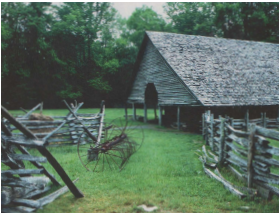July 12, 2012
Special to Indian Country Today Media
A scene from “Unto These Hills”
Amid the majestic scenery of the Eastern Band of Cherokee Indians’ 56,000-acre sovereign nation known as Qualla Boundary lies the city of Cherokee, which sits at the entrance of North Carolina’s Great Smoky Mountains National Park. The area is steeped in Cherokee history and culture and a beautiful setting for a vacation adventure.There are many ways to enjoy a visit to this region. But first determine your vacation expectations. Are you pumped by the glamour and glitz of an all-night casino and a swank suite in a luxury hotel? Or do you picture yourself luxuriating in a hot tub in a rustic cabin nestled snugly in the woods? Does the outdoor life beckon? There’s backcountry exploring along the Appalachian Trail or driving the iconic Blue Ridge Parkwayand camping beside miles of stocked trout streams where you may be visited by curious elk and wake to the chirp of the Eastern bluebird. In Qualla Boundary, or very nearby, you can choose from any one of these options and at a price to suit every budget.
What to Do
For nature lovers a good place to start is at the Oconaluftee Visitors Center and Mountain Farm Museum in the park, run by the U.S. National Park Service, where you’ll learn about the early farming history of the region. You can pick up hiking and topographical maps, light camping supplies and info on the region’s flora and fauna. Resident naturalist Ila Hatter encourages amateur botanists to get in touch with the power of the plant and shares her extensive knowledge of the area’s native plants and their use for food, medicine and crafting. “The Cherokee word adowahi means the spirit of the plant,” she explains. “You ask the power of the plant to do the healing. It keeps its strength in the plant to be your medicine. It can also mean ‘forest’ or ‘guardian spirit.’ It’s comparable to the Buddhist concept of living gratefully.”
Mountain Farm Museum
Whether roughing it or living the luxe life, you’ll want to experience Cherokee culture. Spend time in the Museum of the Cherokee Indian, which has an astonishing collection of Cherokee and Paleo artifacts dating from 10,000 years ago. Here interpretive dioramas of early life mesh with dramatic videos depicting ancient myths and legends. Among carved basswood tribal masks and stone gorgets is the rifle used to execute Cherokee hero Tsali in 1838. Ask for museum interpreter (and well-known stickball expert) Jerry Wolfe, who happily shares his extensive knowledge of traditional recipes and local lore.
Directly across the road is the Qualla Arts and Crafts Mutual, an artisans’ cooperative with more than 250 members. The modern studio-like space, which houses exquisite early and contemporary pottery, beadwork, dolls and museum-quality white oak splint basketry, is a marketplace for authentic Cherokee crafts.
The Eternal Flame greets visitors at the 18th century Oconaluftee Indian Village and Living History Museum. Cherokee demonstrators encourage hands-on participation in weaving, carving, pottery, flint knapping and other traditional crafts. A guided tour of the Cherokee Botanical Garden and Nature Trail is also offered. It is part of the North Carolina Birding Trail System, and features more than 150 native plants through a half-mile loop along the slopes of Mount Noble. Be sure to pre-purchase tickets to the spectacular outdoor evening performances of Unto These Hills at Mountainside Theater. This moving portrayal of the Cherokees and the Trail of Tears told through dance, music and drama is held in a vast amphitheater. During the day special “Step-On” bus tours led by guides in traditional dress can be arranged by contacting the museum in advance.
Master woodcarver, tribal culture bearer and gifted storyteller Davy Arch is the village’s manager and one of the lifeways guides well versed in Cherokee lore. Call the Cherokee Historical Association in advance to arrange traditional suppers or guided trips to Mingo Falls or Soco Falls with its mountaintop observation deck overlooking Maggie Valley.
Just outside of town in a valley along the Tuckasegee River lies the Kituhwa Mound, the center of what is considered the “Mother Town.” The site, established 11,000 years ago, was once an ancient village considered by the Cherokee the center of the universe. Arch brings groups here to talk about the site’s importance as the first Cherokee village and the spot where the sacred fire was kept burning.
Sporting activities in the area include fly-fishing with Rivers Edge Outfitters guides (in Spruce Pine, North Carolina), zip-lining with Adventure America’s Nantahala Gorge Canopy Tours in nearby Bryson City, where you can also ride the rails in restored vintage railroad cars at the Great Smoky Mountains Railroad. Or spend a few hours tubing and kayaking on the Oconaluftee River from Big Cove. A spectacular view of Clingmans Dome, at more than 6,600 feet the highest peak in the Smokies, can be yours on horseback with Cherokee guide Goodlow Bark, owner of End of the Trail Riding Stables.
Where to Eat
Restaurants abound and there are four plus a food court inside Harrah’s Cherokee Casino & Hotel, but more traditional fare can be found at Paul’s Family Restaurant on Tsali Boulevard. The stream-side cottage with outdoor deck features blueberry frybread, buffalo rib-eyes and burgers, pheasant, rabbit, mountain trout, Indian chili tacos, fried green tomatoes and homemade coconut cake.
Since 1977 Cooper’s Roadside Stand, has been boiling peanuts in giant iron cauldrons on the side of Paint Town Road. Be sure to pick up some “rat” cheese (a sharp cheddar), locally grown produce, country ham and some unique jams and jellies like kudzu or wild dewberry.

View of the Great Smoky Mountains from the Sequoyah National Golf Course – photo credit Jordan Wright
Where to Stay
Luxury—The 21-story Harrah’s Cherokee has the most luxurious accommodations including four restaurants, a food court and a casino, currently under a major expansion. Book ahead if you want to hit the greens at the nearby Robert Trent Jones II–designed Sequoyah National Golf Course. The hotel is proud to be a participant in Harrah’s award-winning CodeGreen environmental sustainability and energy conservation program and recently installed 150,000 square feet of sedum on their new porte-cochère roof.
Comfortable Adventuring—A 45-minute drive from Cherokee on the western side of the Great Smoky Mountains National Park is the Fontana Village Resort on the 30-mile-long Fontana Lake. The 400-acre property has a large marina and features a great lodge, private cabins or riverside tent camping. With plenty of planned activities throughout the day, it’s like summer camp for the whole family. Free concerts are held on weekends and evenings are for gathering around the fire pit, karaoke contests, sunset pontoon boat cruises, ghost tours and Indian storytelling. While there plan to visit Fontana Dam. At 480 feet high and 2,365-feet across, it’s the tallest concrete dam east of the Rocky Mountains.
The Lodge at Fontana Village Resort
The Outdoor Life—Tents, cabins and RV campgrounds are in every nook and cranny. Within walking distance from town is the Cherokee Campground & Craig’s Cabins where you can put your fishing pole in Soco Creek right outside your cabin door. For camping with a pool and plenty of kid’s activities try the local KOA campground or the Adventure Trail Campground.
Upcoming Festivals
Eighth Annual Festival of Native Peoples—July 13 and 14
Cherokee Blueberry Festival—August 11
Southeastern Tribes Festival—September 14 and 15
Centennial Cherokee Indian Fair—October 2 through 6








Leave a Reply